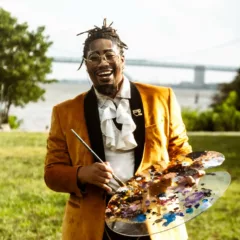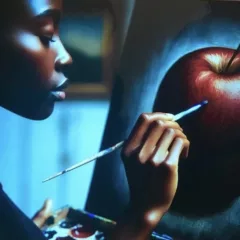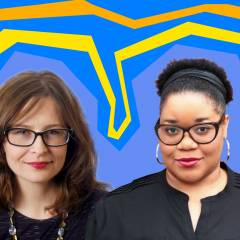Writer’s Preface
I arrived at my first Art Basel Miami Beach on a Saturday afternoon, entering the east entrance of the air-conditioned Miami Beach Convention Center, a 60,000 square feet facility (with a capacity of 2,700 people). Workers in white jumpsuits scanned my timed ticket. The inside was a crowded, inviting smorgasbord of painting, drawing, sculpture, installation, text, and so much more. Nearly three-hundred galleries filled every nook and cranny, open ended, no doors, separated only by corners, spaces, and signage. I spent four hours around splendid art and thousands of strangers, the increased stimuli almost causing my exhausted eyes to burst. I may not have seen the entirety of 60,000 feet, but I did cherish the splendid things that caught my attention in the midst of it. I will give you my comments on individual pieces that spoke to me.

At Jack Shainman Gallery, booth B3, Lynette Yiadom-Boakye’s large-scale painting captured a riveting fantasy of arched exercise, her brusque brushstrokes inventing a graceful dalliance between two dark-skinned women stretching out towards each other. They mirrored movements and each other’s style— the same muscles throbbed in their necks, their lithe bodies dressed in similar emerald green leotards and black tights, and twin, high ponytails balled at their heads. The shadowy background is also emerald green yet the intense color does not intrude upon the acute symmetry of the untouching figures. Both women have an arm stretched out and the other grasping onto their toes. Is this a singular ballet dancer posing in a studio glass? Or sisters, friends, or peers mimicking each other’s limber exercise— their faces breaths away? Their mysterious connection echoed the duality captured in Yiadom-Boakye’s haunting short story, “In the Very Nature,” noting the resemblance of Jackdaw and the Carrion Crow, “somewhere between the contact lenses and the cataracts. It is wise to note the differences, should you happen to meet one or the other, for both hate to be mistaken for the other.”
“Many Faces On Jupiter,” Kudzanai Violet-Hwami’s magnificent mixed media painting at eighty-seven feet high and seventy-five inches in width, took up an isolated wall at Victoria Miro— a gallery based in London, England located in booth A13. Composed of a UV print, oil and acrylic paints, charcoal, and pastel, the materiality of this broken up grid contained seven distinctive separations, Black bodies in various states of motion— relaxed, reading a book, nude stretch, a negative. Deliberate thick white paint either gushed out (crashing below the sharp-edged red book) or appeared as calculated marks atop saturated blues. The bottom— a whole rectangle— featured two realistically rendered bulls, monochromatic and touched with blue. Violet-Hwami merges representational and non-representational forms in the same work, inventing intriguing narratives with concentrated color, loose painting technique, and pieced collage elements.
Meanwhile, other incredible artists worth noting included Wangari Mathenge— simultaneously showing at two galleries, Los Angeles based Roberts Projects, booth B9 and London’s Pippy Houldsworth Gallery, booth C20. Her energetic paintings featured domesticated Black women immersed in opposing patterns. Their bodies existed between sitting or lying, safe and comfortable in tailored environments. Whether it is evidenced by the stylish clothes they wear, their uniquely depicted hairstyles, and the warm, lively places they inhabit, Mathenge’s rich, vivid figurative paintings revealed a genuine authenticity of their individualism; the care for them evident in her meaningful brushstrokes.
New York’s Ryan Lee Gallery, at booth S8, offered an eye-opening view of Vivian Browne’s Africa series. Her abstract paintings experimented with diverse lines and jazzy contours, her palette choices subdued yet whimsical and bright. While Jean-Michel Basquiat and Bob Thompson were among the past Black artists on view, it was an absolute pleasure to witness Browne too being bestowed upon the public. Thus, I could not resist thanking the curators. In turn, they gifted me a beautiful catalog that included an essay written by Dr. Leslie King-Hammond who said of Browne, “her artistic journey was arduous; she worked relentlessly throughout her life to infuse her paintings, drawings, and prints with what she believed to be real humanistic experiences.”
At every turnaround, an artist caught my eye and made me stay with them. For example, April Bey’s afrofuturist tapestries displayed by Vielmetter Los Angeles, booth A16. “Colonial Swag: Not Conceited, CONVINCED’s” sherbet colored background enhances the Black woman sporting a teal bonnet and bright yellow, high-collared jacket with large orange buttons. A Royal Crown Hair Dressing jar— the sacred ancestral hair grease giving little girls shiny braids and little boys glossy waves— sits at the middle of her head. Smaller jars rest below her shoulders.
Also located at Vielmetter Los Angeles— Robert Pruitt’s dual life-size mixed media drawings combine a refined regality with ancient mythology. In “Seated Woman With Quantum Headdress,” a sophisticated figure with an elaborate updo, donning a cerulean gown coated in tiny white polka dots, has her profiled face covered in intricately crafted lace. A snake wraps around her middle finger. Whereas “Standing Woman with Quantum Headdress” features a modern Medusa figure staring out at the viewer, snake-like forms whipping about her modest crown and long, blue-tinted braids. She wears a cerulean tank top and form-fitting pants.
Of course, a few reunions happened. I reconnected with Jonathan Lyndon Chase’s multidisciplinary work at Company Gallery, booth B65, admiring the bold, outlined figure centered around two horses, a spiritual composition overwhelmed with soft, dreamy color. On the left side, the top horse’s face appeared rapturous and carefree, its mane wind blown and flowing. The other horse crouched on the right side, gave an almost protective vibe, its pink ears raised and pointed like devil’s horns. Chase’s avant-garde purple book, “wild wild Wild West / Haunting of the Seahorse” contained photocopied drawings, images, text, and other collected material.
Devon N. Morris, an interdisciplinary who just completed Studio Museum Harlem’s renowned Artist-in-Residence program and runs the 3 dot zine, took over at Deli Gallery, booth P1. The multifaceted installation is a rich, theatrical stage that includes several mixed media paintings, embellished assemblages, and organic sculptures in a golden yellow realm (a nice contrast when most booths were pristine white). They are tied together by cords, harmoniously connecting tender moments together that showcases life’s vulnerable threads, revealing people as thriving existing bodies framed by generous curtains and asymmetrical wood pieces.
Overall, Art Basel operated purely on an eclectic menagerie of talent from around the world and on the fact that many do not have opportunities to visit faraway galleries they would probably never get the chance to visit.
Art has always held the power to generate dialogue, upstart unexpected conversations from the artists, curators, art historians, collectors, or plain ole admirers. It was a wonderful privilege to attend this momentous occasion, watching the past mingling with the promising future. Art Basel also reminds me of migrating to new places, determined to see everything that a new city has to offer despite any incoming exhaustion. When time is of the essence and your eyes and phone are your tools, you feel invincible, as though your own tired feet cannot stand in the way of your documentary purpose.
More information about the founding of Art Basel here. And for more general information on the art fair here.
For further reading we suggest:
Ilana Napoli’s review of Lynnette Yiadom Boakye’s 2017 exhibit at the New Museum
Works Cited
Vivian Browne Africa Series 1971-1974 Catalogue. New York, Ryan Lee Gallery, 2022, pg. 3.
Yiadom-Boakye, Lynette. Natures, Natural, and Unnatural. London, Whitechapel Gallery, 2015, pg. 34.









